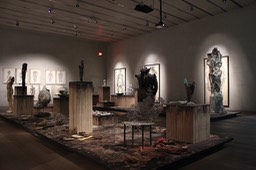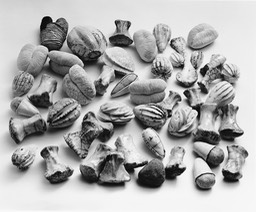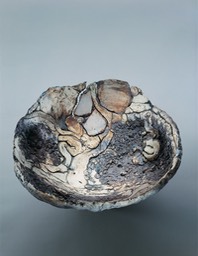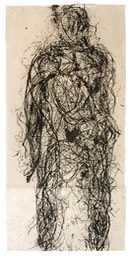At Pérez Art Museum Miami, a homecoming for a home girl
BY GEORGE FISHMAN
When Michele Oka Doner was a young girl, she played Tarzan in the massive banyan tree that filled a vacant lot near her Miami Beach home. Sixty years later, during the final hours of installing her retrospective exhibition at Pérez Art Museum Miami, she crouched over the softly stained platforms where her own works are intuitively arrayed alongside kindred forms from nature.
“I became a sculptor because of the shapes around me,” she recalled. “The silhouette of trees in the evening and the seeds that fell out of trees — these memories are primal — there before I’m 5.”
A large mango tree in the backyard also introduced her to the vivid pungency of nature’s cycle: blossoming, fertilization, fruiting, ripening and decay. “The sense of process and time and the physical senses are all engaged when you grew up here and are outside,” she said.
And there was the beach itself with washed up crab legs, bits of coral, seaweed and shells. Today, thousands of voyagers traverse Miami International Airport’s mesmerizing terrazzo floor, admiring the gleaming bronze and mother-of-pearl replicas of marine life embedded in it — often without knowing that the designer of Walk on the Beach is a home girl.
Visitors to the museum exhibition will see an experimental film based on that floor and likely have an “aha moment.” Though Doner long ago moved to New York, she remains intrigued by discovery and manipulation of nature’s gifts — whether on her studio floor, a forest, airport or museum floor.
The artworks and artifacts that comprise How I Caught a Swallow in Midair are generally more representative of the earth and sea than of the air, but the exhibition certainly captures the soaring spirit of its title, and she does, in fact, incorporate the sparrow image in a cyanotype print.
The basic desires to make sense of life and locate the self within the universe have been lifelong pursuits for Doner, paralleling mankind’s primordial search for meaning and the tools of communication.
Her exploration doesn’t maintain a rigid hierarchy between “what is the natural world, what is an ancient artifact, what is a contemporary material, what is literature, what is fine art, what is craft,” said PAMM’s chief curator, Tobias Ostrander. “All these things are mixed together.”
Her exhibition interweaves pieces, such as Volcanic Bowl, made when she was a 19-year-old student and still learning to adopt the “happy accidents” that take place in the ceramic kiln, with current works. Sculptures are nestled among natural objects and aboriginal talismans collected during extensive travels. Low light, suggestive of a secret ceremony, provides evocative ambience to the installation, which complements the museum’s finely honed surfaces. The ensemble resembles a wunderkammer or “cabinet of curiosities” — a centuries-old collecting tradition.
This unstratified melding of natural and man-made objects intrigued former PAMM director Thom Collins, who initiated the exhibition, selecting works from Doner’s Brooklyn loft/studio. He interviewed her for the catalog, as did writer Rebekah Rutkoff, who contributed an intimate essay. “In high school, when I first looked into the microscope,” Doner told Collins, “I understood the profundity of biology, the science of life. The structure of cells, their growth and reproduction, keyed into those early desires to understand and connect to the world.”
STUDIES AND INFLUENCES
Before she began collecting, Doner learned about African and pre-Columbian art from her professors at the University of Michigan during the 1960s, who returned from sabbaticals with stories, photographs and even artifacts from their travels: Walter Spink from the Ajanta (India) caves, Oleg Grabar from Syrian castles and Richard Edwards from China’s Han dynasty caves.
“These people had touched it. They were fresh, they were young, they were passionate. They were inventing history,” she said during a recent exhibition tour. The infectious enthusiasm of these teachers informed Doner’s evolving sense of art’s global wellspring. “The people of Oceania were certainly looking at the same things I was,” she said.
Doner’s forms from the 1970s — mostly hand-molded ceramics — encompassed her own versions of tribal burial objects and other totemic forms, along with bone, seed and organ-like shapes. During her student years, “painting stripes and targets and welding I-beams” constituted the dominant aesthetic. “Come on, Michele, get with the program,” exhorted her colleagues. Those formats held no appeal to Doner. “I had to develop a strength of my convictions. I had to become what I call ‘a stealth warrior,’ ” she said.
Though she worked outside the prevailing genres of minimalism, pop styles and the domineering “boy’s club,” Doner’s work still was included in prominent shows and attracted such influential writers as Lucy Lippard and Grace Glueck. Her Seeds and Pods, from the late 1970s, translate once perishable ribbed, cloven, radiating, undulating life forms that she has collected since childhood into the permanent artistic medium of glazed porcelain. Her Pictographs, from the same period, explore the graphic origins of language, which themselves parallel such fundamental phenomena as germination, branching and the growth of a galaxy or embryo.
A decade later, her bronze Celestial Chair joins one circulating pattern that resembles a radar image of hurricane winds with another resembling the Spiral Nebula. The accompanying bones, stones and seeds evoke the Willendorf Venus, brain scans, sexual organs, and letters from real and imaginary languages.
Doner’s work is informed by a lifetime of reading and thinking. As children, “we were expected to show up at the dinner table and sit up and be able to speak and to lift our heads and not mumble and to have ideas,” she said. Literature has provided a consistent backdrop to Doner’s sense of her place in the world — including her local roots. During a recent PAMM tour, she quoted from Wallace Stevens’ poem Nomad Exquisite, “The immense dew of Florida brings forth the big fin palm and green vine angering for life…” And from Zora Neale Hurston’s Dust Tracks on a Road, “Like the dead-seeming, cold rocks, I have memories within that came out of the material that went to make me. Time and place have had their say.” All share a transcendental convergence of the local and universal.
Her figurative sculptures Nonnus, Hestia and Horace reflect the names and forms of Greco-Roman deities, poets and philosophers. Others, clothed in the textures of seaweed, bark, roots and coral, appear to be simultaneously growing and dissolving.
Doner’s Adam and Atlas are among the relief prints she made by assembling roots and twigs to resemble nerves or blood vessels within a man’s outline. Other prints similarly reflect the interconnections between human and other life forms — all subject to the foraging of insects, rot, fire, erosion and similar forces.
She utilizes common materials like burnt wood and wax as well as gilded bronze, etched glass and silver, melding craft, design and fashion. Mekko, her monumental concert pavilion sculpture in Downtown Doral, was designed “by taking two pieces of bark, scanned and worked up in CAD.”
Though her roots are, literally, often in plant and tree roots, 21st-century materials and techniques such as 3-D printing have become part of her repertoire. “It enables me to stretch,” she said. That stretch even extends to thinking fearlessly about robotics and cyborgs. “The minute we put the pacemaker in we had crossed the line. And let it be a happy thing,” she said.
This spring she designed the costumes and sets for a novel, underwater reimagining of George Balanchine’s A Midsummer Night’s Dream for Miami City Ballet. She likened the project to her MIA airport floor: “It is a stage set and it’s choreography and it sets the stage for arrival and departure.”
Doner takes commissioned projects in stride, recognizing that “When they’re paying you to work you cannot assume you can do anything you want. So then begins the negotiation.”
CHANCE PHILOSOPHY
While never aligned with the hard-edged painting, minimalist sculpture or ironic pop references of her contemporaries, Doner was spurred by the vibrant artistic community she found in New York. Influences included dancer-choreographer Merce Cunningham and experimental music wizard John Cage, who used chance as part of his M.O.
So, too, has Doner left outcomes to the kiln gods’ unpredictable whims. Her Scapula and Burial Pieces were fired in the centuries-old Japanese tradition of wood and straw-burning raku kilns and even older pit firing methods. In both, the shape of heat chambers and erratic burning of fuels result in variable heat circulation and unpredictable, crackly smoke-stained surface effects.
These artworks showcase Doner’s deep reverence for natural forms; they also register the yin and yang of asserting and relinquishing control over natural forces and materials. A balance of intention and happenstance, the temporal and timeless, the handmade and the found — all recur in Doner’s work and writings.
Ostrander calls it a shamanistic approach that invokes the collective unconscious across time and geography. “The tremendous lack of irony in her work and a super lack of care about originality — that goes contrary to most current practice,” he said.
For Doner, individuality and steadfastness are second nature, not a stance. “You have to be like a good dog,” she said. “You have to know your own bone. Dogs never dig up another dog’s bone.” And while clearly passionate about collecting, she’s also philosophical about it. “I will consider my life successful if the things I love the most I can put into my handkerchief at the end of the day.”
If You Go
Read more here: http://www.miamiherald.com/entertainment/visual-arts/article78885842.html#storylink=cpy



